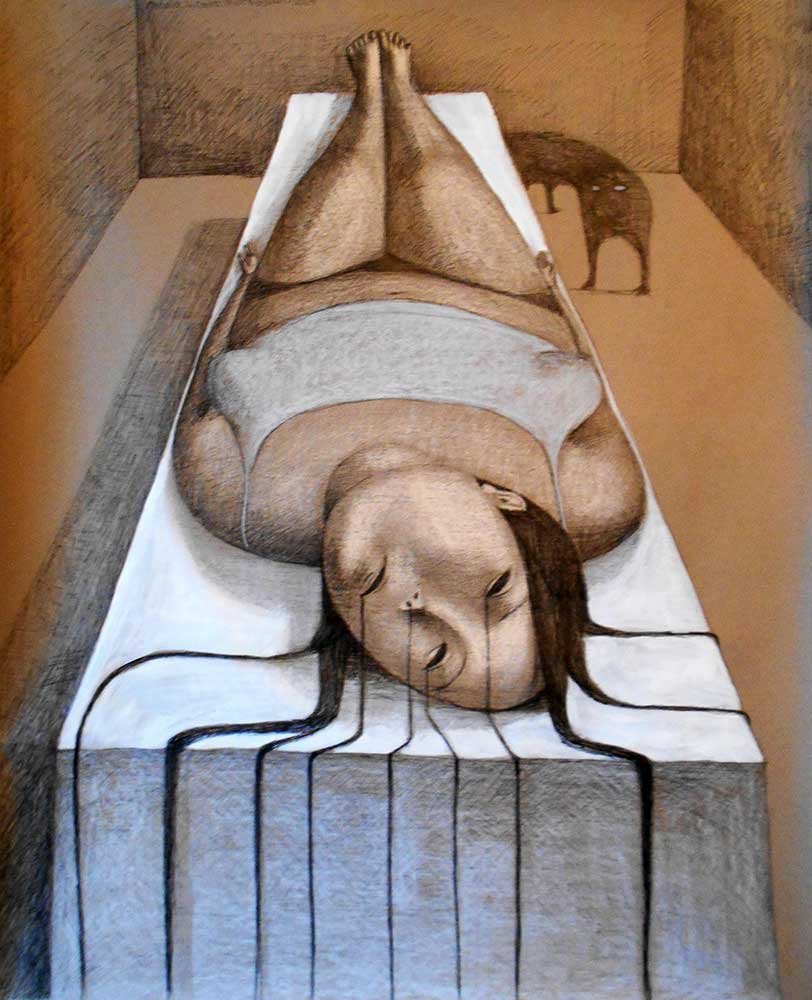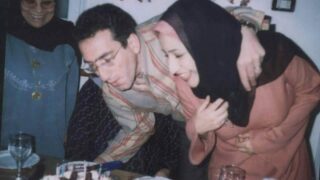
This publication has benefited from the support of the Rosa Luxemburg Foundation. This text may be reproduced in part or in full, provided the source is acknowledged.
It is almost a hundred-year-old journey during which the efforts and actors in the struggle against FGM have diversified. Perhaps more than any other entity, civil society was most involved in forming an organized front for confrontation, maturing its efforts in the process: voices, pens, civil associations, feminist associations, universities, and religious institutions. The role of the authorities came only later, as the state adopted the fight against this internationally prohibited custom. The struggle journey was - and still is – marching towards eradicating the brutal practice of removing parts of the female external genitalia. Despite this, some people in Egypt still practice the crime of FGM, shamelessly putting forward arguments that are insulting to women. In the least of estimates, FGM affects 91% of all Egyptian women, according to a survey (1) conducted by UNICEF in 2015, in cooperation with the Egyptian state.
Asmaa is an activist devoted to this cause. She has accumulated experiences that were neither in vain nor yet fruitful, but that were certainly helpful in instilling the first building blocks on which the construction of a solid struggle becomes possible, no matter how long it takes, for the sake of the young girls whose lives get ruined every day. Everyone, whether in favor of FGM or against it, has become convinced that we are not facing an ordinary, tangential matter. Those who still practice FGM today know that their actions are accused of decadence. After all, how can they escape the shame of leaving their young girls at the mercy of a doctor with a scalpel or a woman trying to stop a heavy bleed with a little cloth.
The first steps... Roads diverged and converged
In her observational study "FGM: A Struggle Throughout History," Egyptian researcher Mai Ajlan (2) mentioned important and indicative stages of the magnitude of the challenges faced by the pioneers of the struggle, the depth and propagation of the movement, and what she believes is lacking until the present moment.
Her study showed that the first step was taken on 28 December 1928. During a conference held in Cairo, Ali Pasha Ibrahim, the world-class Egyptian surgeon and the first Egyptian dean of the Al-Qasr al-Ayni Faculty of Medicine, announced that he had neither learned FGM nor taught it to his students. He advised against performing it, pointing out that he was informed about FGM directly by the girls who had asked him to save them from its consequences.
The incident launched a series of responses from male and female writers who wrote articles and led press campaigns against the harmful habit. They demonstrated its medical uselessness and argued that it had nothing to do with religious practices. Moreover, the discussion touched on the right for the two sexes to enjoy sexual relationships, considering FGM a crime, as stipulated in international covenants.
The first official reaction came after nearly 30 years, specifically in 1959, when the Minister of Health issued Resolution No. 74 in June 1959 banning FGM in hospitals and health units of the Ministry of Health. Unfortunately, this was not reflected in a public awareness in Egypt of the dangers of the phenomenon, and no decline was registered in the rate of its practice, as it was common that a midwife or barber would perform the job without the need for a hospital or clinic.
Until that time, those calls against FGM existed only son paper, be they in the form of articles or resolutions. Hence, they were all confined to the educated circles in a country where the illiteracy rate exceeded 80%. Of course, the readers of such articles were nowhere beyond Cairo and the main cities. There was a need to get down on the ground and form proactive groups. Fortunately, the growth of the feminist movement during that period coincided with the state's political will to support some political and social rights for women. Those rights included the government's approval of political participation, such as women's right to run for office and vote. However, the weakness of the organizational frameworks in general and the dominance of a single political organization system contributed to limiting the movement of those feminist groups on the ground and their visits to the main areas of hamlets and villages, especially concerning contact with a crucial issue such as FGM.
The first step was taken on 28 December 1928. During a conference held in Cairo, Ali Pasha Ibrahim, the world-class Egyptian surgeon and the first Egyptian dean of the Al-Qasr al-Ayni Faculty of Medicine, announced that he had neither learned FGM nor taught it to his students. He advised against performing it, pointing out that he was informed about FGM directly by the girls who had called him to save them from its consequences.
Civil society movements concerned with FGM emerged in 1979 with the establishment of the Cairo Family Planning Association (CFPA). Chaired by Dr. Aziza Hussein, the CFPA witnessed, for the first time, a pioneering seminar on "Physical Mutilation of Young Females in Egypt." Held at the main headquarters in Cairo and many Egyptian governorates' offices, the seminar presented the first field study prepared by Mary Asaad on FGM in Egypt. Asaad formally presented her study on behalf of the Egyptian state during a meeting held by the World Health Organization (WHO) in Khartoum on practices harmful to women's health.
The first battle: When everyone chose a camp
This issue witnessed a convergence in the views of the official, civil, and human rights institutions. Perhaps the reason lies in its seriousness and deep entrenchment in the popular fabric until the 1950s as a custom and a habit linking the reduction of women's sexual desire with the increase of the ability of men to sexually enjoy themselves. Historically, FGM has been performed in only 27 African countries worldwide, including Egypt and Sudan. According to UNICEF statistics (3), Egypt came in third place in terms of its prevalence after Ethiopia and Somalia. The survey said that the number of girls and women who have undergone FGM worldwide is 200 million.
The issue of FGM constituted a meeting point for various intellectual trends, save the two wings of the Islamic trend; i.e. the Muslim Brotherhood and Salafism, in addition to other Islamic movements whose influence has been increasing since the mid-1970s. The rise of political Islam and the spread of its ideas coincided with the beginning of the struggle against the practice of FGM. Therefore, its supporters took their position as defenders of a custom for which they instilled a religious character. From their pulpits, they defended FGM and delivered doctrinal justifications supporting their point of view despite the fact that FGM is completely absent in the Arabian Peninsula, the major intellectual supplier of religious books circulated among the Muslim youth and sheikhs at the time.
The political and economic climate played a fundamental role in influencing the situation at the time. Development rates in Egypt increased until the early 1980s. However, their curve began to decline, in addition to the decline in financial allocations for education, health, public culture, construction, and road maintenance. Causing a downfall in the efforts to eradicate illiteracy, the situation also led to a spread of school dropouts, domestic violence, and other adverse practices. This situation was exacerbated by a patriarchal-authoritarian climate and a fierce resistance to the eradication of FGM in rural and Upper Egypt, in the name of custom and, sometimes, religion.
In her book “Women and Sex” (4), physician, writer, and feminist activist Nawal El-Saadawi detailed all these motives and arguments in an early and shocking manner. Four editions of that book were published in one year, and the writer consequently waged a campaign alone against several entities. The most important fight was the one against the Egyptian Medical Syndicate and all its members who perform FGM in their private clinics. The syndicate ended the quarrel by dismissing El-Saadawi from her position under the pretext of lacking discipline and hurling insults at her colleagues.
The first real battle bore fruit after nearly twenty years. In 1994, the first national public committee to eradicate FGM was formed, with several NGOs' participation. Simultaneously, the International Conference on Population and Development was held in Cairo, which shed intense light on the phenomenon and its consequences. However, the then Egyptian Minister of Health retracted the decree prohibiting FGM, which had been in effect for 35 years, and adopted an administrative resolution to open public hospitals to perform FGM at the parents' request. Although the preamble to the resolution included an enumeration of the harms of FGM, the Minister allowed it on the condition that it be practiced only by specialized doctors.
The practice of FGM is rooted in the popular fabric as a custom that reduces women's sexual desire for the benefit of men’s ability to increase sexual enjoyment. FGM is performed in only 27 African countries worldwide, including Egypt and Sudan. Egypt comes in third place in terms of prevalence after Ethiopia and Somalia, and the number of girls and women who have undergone FGM worldwide is 200 million.
The decision was met with major social resistance and mass media campaigns. Several female human rights activists also filed a lawsuit in which the court ruled, after three full years, to cancel the administrative decision. This fight brought to light several voices and perspectives worth noting.
First, regarding the official position, the Health Minister and the decision-makers in his administration defended their view by emphasizing their acknowledgment of the harmfulness of FGM and their rejection of performing it. However, the widespread of FGM throughout the republic and its practice by non-medical professionals, which resulted in hemorrhages that often led to death, made them, per their point of view, accommodate the status quo by allowing surgeons affiliated with the Ministry of Health exclusively to perform FGM. However, the Supreme Administrative Court rejected their view, based on the jurisprudential rule that consecrating an unlawful act is not permissible. It recommended that the state take the necessary legal, security, and societal measures to address this habit that violates international conventions.
Second, regarding the Islamic movement’s position, Islamist lawyers have been active in initiating counter-suits demanding the annulment of the court's decision and the reinstatement of the old resolution. Although the court dismissed the lawsuit, the petitioners, or those who pursued their approach, lodged it several times. Perhaps the most famous of these was the 2007 battle, in which a lawsuit was filed in a context that witnessed the spread of private satellite channels in Egypt, including religious ones. Some, particularly the Al-Nas TV channel, broadcast campaigns by well-known Islamic preachers such as Safwat Hegazy, who led a campaign to defend FGM.
What he mentioned was at the heart of the lawsuit memorandum submitted to the court. It stated: "The memorandum has contained the authenticity of the hadiths of the Prophet, their conclusive evidence of the righteousness of female circumcision, and the consensus of the imams and scholars of Islam concerning its validity. The scholars unanimously agree that female circumcision is recommended because it honors the female and is for her benefit. It is one of the characteristics of Fitra (instinct) and the rituals of Islam. We insist that it is not permissible to rely on the opinion of a human being, even if it is a doctor, as long as there is an authentic hadith on the matter by Prophet Muhammad (PBUH), who does not speak out of whims. Therefore, we conclude that female circumcision is physically and morally beneficial to the female.”
With the arrival of the Islamist movement to the executive and legislative authority in Egypt in 2012, it was not surprising that similar practices resurfaced. The Freedom and Justice Party of the Muslim Brotherhood organized convoys to the villages of Minya to invite the people to perform FGM operations under the supervision of doctors and to provide the means for that.
Reality and statistics
As far as the NGOs are concerned, the decade (1997 to 2007) was the main period during which many voices emerged. They called for initiating national campaigns to raise awareness, correct beliefs, and enact legislation criminalizing FGM and punishing the legal guardians and the perpetrators. Moreover, mass media, human rights organizations, women's NGOs, and several official institutions held extensive discussions with Al-Azhar Foundation, the Scientific Society of Obstetrics and Gynecology, and the Egyptian Medical Syndicate to formulate a common discourse, which was largely achieved.
Efforts are still ongoing, cumulative, and undoubtedly evolving. Despite this, they remain limited due to the extensive practice of FGM. That is what activists and workers in nearly two hundred civil institutions in addition to the official authorities now realize. They have grasped just how difficult it is to enter every home and effect change, even more so to illuminate minds and soften hearts.
Two conferences were held at the end of the 1990s to consolidate the collective position. The first was the International Conference on Population and Reproductive Health in the Muslim World, which ended with a statement confirming that the Prophet Muhammad did not recommend female circumcision. In 2005, the International Islamic Centre for Population Studies and Research at Al-Azhar University issued a book, "Towards the Elimination of Female Genital Mutilation," which some consider a legitimate reference.
The second was the annual joint conference of the Egyptian Society of Gynecology and Obstetrics and the Egyptian Society for Fertility Care, in which a special session was devoted to FGM. It ended with announcing a position that stated: “FGM is an unnecessary, harmful, and dangerous practice that a doctor who swears to respect the medical profession may not perform. Also, cases born with congenital anomalies that require complementary surgeries on the female external genitalia are surprisingly rare. It is a delicate surgery that needs careful evaluation by a team specializing in genetics, endocrinology, and pediatric surgery. That surgery does not include the removal of the clitoris or the labia, and it is not called female circumcision.”
At the same time, the National Committee for the Elimination of FGM was already established under an official umbrella that allowed dozens of NGOs to collaborate, some of which worked on the ground, especially in slums in Cairo and Upper Egypt villages. Its central role was to provide services to women, such as eradicating illiteracy and financing small projects for economic empowerment, and raising the level of reproductive health. In this context, awareness lectures and seminars were held for mothers to urge them to abandon the custom of FGM.
These civil society initiatives had an impact that led the state to adopt a similar approach. In 2003, the government attempted to reintegrate and network these activities under another broad and enthusiastic title, the National Program. Per the program, 120 villages were identified as a first stage to declare them FGM free, most of which were in various areas in Upper Egypt and witnessed the activities of some of these NGOs. But like other major headlines, it quickly faded, and the first stage results were not announced. Civil society tried to sharpen its energy again and away from the official umbrella. In 2009, it announced the establishment of the "Egyptian NGOs Coalition Against FGM," under its umbrella 145 female outreach workers were trained.
Accurate statistics were absent until the release of the UNICEF report, which gave Egypt a prevalence of 91%. That proved the enormity of the phenomenon despite all the efforts made at the level of official and civil society organizations.
The limited financial capabilities of many NGOs, the lack of seriousness of some of those in charge of the local municipalities entrusted with raising awareness and monitoring, and the deeply rooted religious tide in villages and densely-populated areas are the reasons for the prevalence of FGM despite all the efforts made, according to research by feminist human rights advocate Nihad Abu-al-Qumsan. However, she concurrently noted that her study's detailed figures showed that prevalence varied according to the age group, which may give an impression of the possibility of obtaining better results in the coming years. While the UNICEF report refers to a general prevalence rate, her study (5) gave a high prevalence of 93% among married women aged 15-45, 21% among young girls aged 1-7, and 56% among girls aged 16-17. Monitoring the variation at the level of geographical division, the study stated that the prevalence of FGM in Upper Egypt reached 96% and did not exceed 16% in coastal cities such as Damietta and Port Said.
The issue of FGM constituted a meeting point for various intellectual trends, save the two wings of the Islamic trend; i.e. the Muslim Brotherhood and Salafism, in addition to other Islamic movements whose influence has been increasing since the mid-1970s. The rise of political Islam and the spread of its ideas coincided with the beginning of the struggle against the practice of FGM. Therefore, its supporters took their position as defenders of a custom for which they instilled a religious character. From their pulpits, they defended FGM and delivered doctrinal justifications supporting their point of view.
The National Committee for the Elimination of FGM was established as an official umbrella under which dozens of NGOs were grouped. Some of those NGOs worked on the ground, especially in slums in Cairo and Upper Egypt villages. Its central role was to provide services to women, such as eradicating illiteracy and financing small projects for economic empowerment, and raising the level of reproductive health. In this context, awareness lectures and seminars were held for mothers to urge them to abandon the custom of FGM.
After removing the Muslim Brotherhood from power in 2014, the National FGM Abandonment Strategy 2016-2020 was launched with the participation of all sides to reduce the prevalence of FGM to 10-15% among Egyptian girls aged 0-19 between 2016 and 2020 until eliminating it completely.
The hard truth
The pioneering women working against FGM believe that anti-FGM campaigns have paid off by creating a legislative environment to stifle this practice. Meanwhile, they stressed that the orchestrated campaigns would not have yielded results had it not been for the occurrence of horrific accidents that made the highest impact. In 2007, the Egyptian Dar al-Iftaa (Egypt’s formal Islamic advisory, justiciary and governmental body) issued the first fatwa condemning FGM. It was a deterrent reaction after the media revealed the death of Bodour, an eleven-year-old girl from Upper Egypt, who had passed away in a private medical clinic. In 2008, the parliament passed the first legislation in this regard. However, the first court ruling was in 2015 against a doctor in whose clinic the life of another girl ended. The court sentenced him to two years of imprisonment and gave the girl’s father a three-month suspended prison sentence.
A new feminist societal campaign was launched and ended with making amendments to provide for stricter legal penalties. The legal text adopted by the courts since 2016 punishes whoever performs FGM with five to seven years of imprisonment. Moreover, if the FGM results in a permanent deformation or leads to death, the penalty shall be rigorous imprisonment. Parliament has also added an article that punishes whoever accompanies a female to be subject to FGM, should the procedure be carried out, with one to three years of imprisonment. This article also criminalizes the father, mother, or relative who accompanies the girl. However, this did not prevent the occurrence of other accidents. With the end of the period specified in the National FGM Abandonment Strategy 2016-2020, the media announced a third death under the similar circumstances.
They are several mortality cases that have been exposed from within medical clinics. Although they do not document the truth, they indicate the unlimited number of deaths and permanent disabilities that have not yet been revealed in hamlets, villages, and cities of Egypt over the past hundred years against young girls.
Efforts are still ongoing, cumulative, and undoubtedly evolving. Despite this, these efforts remain limited due to the extensive practice of FGM. That is what everyone realizes now within the nearly two hundred civil institutions in addition to the official authorities who have worked on the matter. They have grasped just how difficult it is to enter every home, even more so to illuminate minds and soften hearts.
Perhaps one of the most successful campaigns in which everyone joined forces and achieved an impact was a long television commercial which explained the dangers every little girl faces throughout the painful experience of FGM and its ramifications on their future. It was the first time a popular discourse had explicitly addressed the falsity of popular beliefs about FGM. Small brochures explaining this in detail were also issued and distributed to medical units and school libraries.
In that TV ad, one of the most touching and telling details was the resemblance the young girl in it bore to Bodour, the girl who passed away during FGM. She is the face of every girl, whether she lived or passed away after the horrific experience. It is a face both innocent and terrified, and it longs for the day this nightmare will be over; a distant memory, forgotten by future generations as if it never existed.
The content of this publication is the sole responsibility of Assafir Al-Arabi and Rosa Luxemburg Foundation cannot accept any liability for it.
Translated from Arabic by Sabry Zaki
Published in Assafir Al-Arabi on 27/06/2022
1- According to what was published by the Egyptian Al-Watan newspaper in 2015. https://www.elwatannews.com/news/details/656825
2- Mai Ajlan, Research Unit of the Egyptian Youth Council, FGM Observatory, Cairo 22, Egyptian Youth Council | Facebook
3- Female Genital Mutilation (FGM) Statistics - UNICEF Data
4- Women and Sex, Nawal El Saadawi, Al-Mustaqbal Publishing and Printing House, 1990, https://binged.it/3A2sHFj
5- Nihad Abu-al-Qumsan, https://youtu.be/CiwFa03Jb4k







